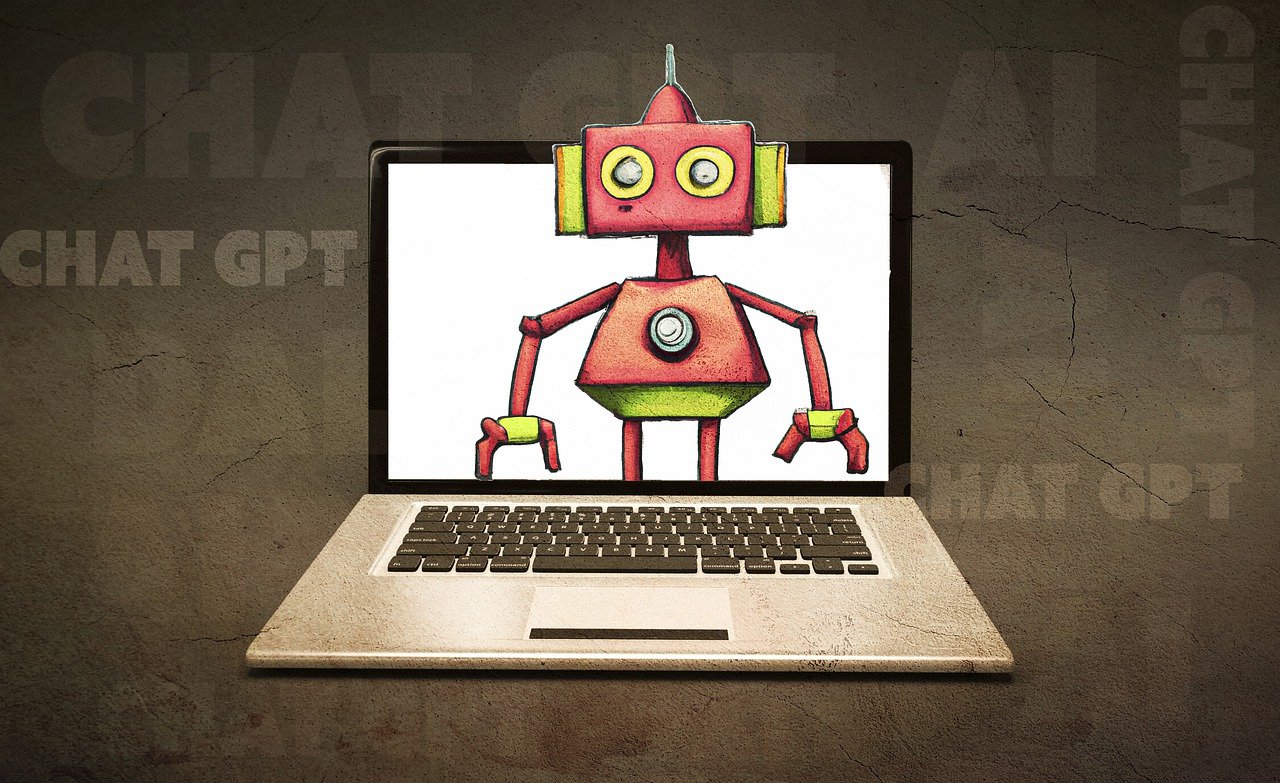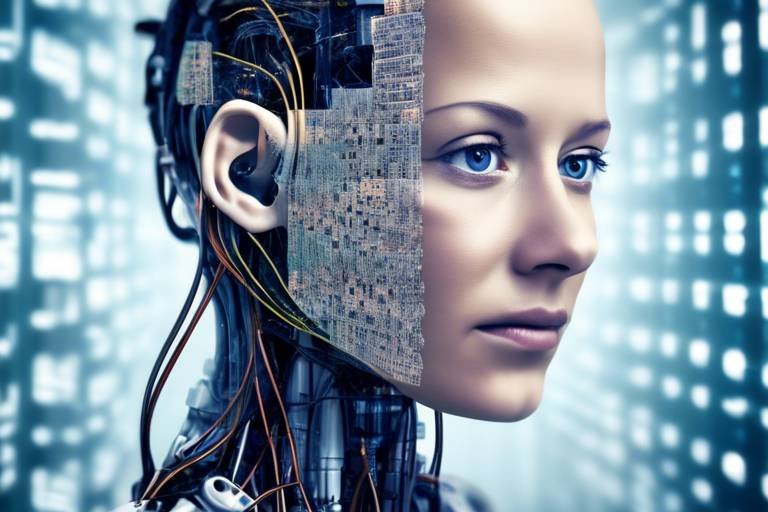Probing the Ethics of Artificial Intelligence
As we stand on the brink of a technological revolution, the ethical implications of artificial intelligence (AI) are becoming increasingly significant. AI is not just a tool; it is a transformative force that can reshape our society in profound ways. From self-driving cars to AI-driven healthcare solutions, the potential benefits are immense, but they come with a host of ethical dilemmas that we must navigate carefully. The question isn't just about what AI can do, but also about what it should do. Are we ready to embrace these technologies, and at what cost?
The rapid advancement of AI technologies has sparked a global conversation about ethics, accountability, and responsibility. As developers and users, we face a multitude of challenges, including bias in algorithms, privacy concerns, and the quest for transparency. These issues are not merely academic; they have real-world implications that affect individuals and communities. For instance, if an AI system is biased, it can lead to unfair treatment of certain groups, perpetuating existing inequalities. This is a wake-up call for all of us to take a closer look at how these technologies are developed and deployed.
Moreover, the rise of autonomous systems raises questions about accountability. When a self-driving car gets into an accident, who is responsible? Is it the manufacturer, the software developer, or the owner of the vehicle? These questions highlight the complexities of legal frameworks that struggle to keep pace with technological advancements. As we delve deeper into the ethical landscape of AI, we must also consider the role of corporations. Are they doing enough to ensure ethical practices in AI development? The implementation of internal guidelines and ethical review boards can serve as a foundation for responsible innovation.
Privacy is another critical concern in the realm of AI. With the capacity to collect and analyze vast amounts of personal data, AI technologies can infringe on our privacy rights. The potential for misuse of this data is alarming, making it imperative that we establish robust data protection regulations. Frameworks like the General Data Protection Regulation (GDPR) aim to safeguard user data, but are they enough? We must ensure that users are not only aware of how their data is being used but also have a say in the matter. Informed consent is essential in an age where our personal information is a valuable commodity.
Looking ahead, the future of human-AI interaction holds both promise and peril. We can envision a world where AI systems work collaboratively with humans, enhancing our capabilities while adhering to ethical principles. This symbiotic relationship could lead to innovative solutions that prioritize human welfare and societal benefits. However, achieving this vision requires the establishment of ethical guidelines that govern AI development. Without a clear ethical framework, we risk creating technologies that serve only a select few, exacerbating inequalities and social injustices.
In conclusion, probing the ethics of artificial intelligence is not just an academic exercise; it is a necessary endeavor that requires our immediate attention. As we navigate this complex landscape, we must remain vigilant and proactive in addressing the ethical implications of AI. Together, we can ensure that these powerful technologies are developed and deployed in ways that benefit all of society, rather than a privileged few.
- What is AI ethics? AI ethics refers to the moral principles and guidelines that govern the development and use of artificial intelligence technologies.
- Why is bias in AI a concern? Bias in AI can lead to unfair outcomes, discrimination, and reinforce existing societal inequalities.
- How can we ensure accountability in AI? Establishing clear legal frameworks and corporate responsibility practices can help ensure accountability in AI development.
- What are the privacy concerns related to AI? AI technologies can collect and misuse personal data, raising significant privacy issues that need to be addressed through regulations and informed consent.
- What is the future of human-AI interaction? The future of human-AI interaction is likely to involve collaborative systems that enhance human capabilities while adhering to ethical standards.

The Rise of AI Ethics
As we stand on the brink of a technological revolution, the importance of ethics in artificial intelligence has never been more critical. With AI systems infiltrating various sectors—from healthcare to finance, and even entertainment—questions surrounding ethical practices are emerging like wildfire. Developers and users alike are grappling with a slew of ethical dilemmas that could shape the future of society. But what does it mean to be ethical in a world governed by algorithms?
The rise of AI ethics is not merely a trend; it’s a necessity. As we integrate AI into our daily lives, we must consider the implications of these technologies. Are they fair? Are they transparent? And perhaps most importantly, who is accountable when things go awry? These questions highlight the urgent need for a robust ethical framework that can guide the development and deployment of AI systems. In fact, many organizations are beginning to realize that ethical AI isn't just about compliance; it's about building trust with users and stakeholders.
One of the key ethical dilemmas faced by developers is the potential for bias in AI algorithms. Bias can creep in through various channels, including the data we use to train these systems. If the data is skewed or unrepresentative, the AI will likely produce skewed results, leading to unfair outcomes. This is particularly concerning in high-stakes areas like hiring, law enforcement, and lending. Therefore, addressing bias must be at the forefront of AI ethics discussions.
Moreover, the ethical landscape of AI also encompasses issues of privacy and surveillance. As AI systems become more adept at collecting and analyzing personal data, the line between beneficial technology and invasive surveillance becomes blurred. This raises important questions about user consent and the extent to which individuals are aware of how their data is being used. Are we, as users, fully informed about the implications of sharing our data? Or are we unwitting participants in a grand experiment?
To navigate these challenges, various ethical frameworks are being proposed. For instance, organizations are encouraged to adopt internal guidelines and establish ethical review boards to oversee AI projects. This not only helps in ensuring compliance with existing regulations but also fosters a culture of accountability and responsibility within organizations. By prioritizing ethical considerations, companies can build trust with their users, paving the way for a more equitable technological landscape.
In summary, the rise of AI ethics is a multifaceted issue that requires the collective effort of developers, users, and regulators. As we continue to innovate, we must ensure that our advancements do not come at the cost of fairness, transparency, and accountability. The future of AI depends not just on technological prowess, but also on our commitment to ethical principles that prioritize human welfare and societal benefits.
- What is AI ethics? AI ethics refers to the moral implications and responsibilities associated with the development and deployment of artificial intelligence technologies.
- Why is AI ethics important? It ensures that AI systems are developed responsibly, minimizing bias, protecting privacy, and fostering accountability.
- How can bias in AI be mitigated? By using diverse training datasets, involving multidisciplinary teams, and conducting regular audits of AI systems.
- What role do organizations play in AI ethics? Organizations are responsible for establishing ethical guidelines and ensuring that AI practices align with societal values.

Bias in AI Algorithms
As we dive into the world of artificial intelligence, one of the most pressing issues that emerges is the bias inherent in AI algorithms. These biases can manifest in various ways, often leading to unfair outcomes that can discriminate against certain groups of people. Imagine a world where decisions affecting your life—like hiring, lending, or even law enforcement—are made by a system that doesn't see you as you truly are. This is the reality we face when biases infiltrate AI systems, and it’s a challenge we must address head-on.
At the heart of this problem lies the fact that AI algorithms are only as good as the data they are trained on. If the data contains biases, the algorithm will likely perpetuate or even exacerbate those biases. For instance, if an AI system is trained on historical hiring data that reflects societal biases against women or minorities, it may learn to favor candidates who fit a certain profile, thereby excluding qualified individuals simply because of their gender or ethnicity. This unintentional discrimination can have significant real-world consequences, impacting lives and careers.
Understanding the sources of bias in AI is crucial for developing effective solutions. Bias can creep in through various channels:
- Data Selection: If the data used to train an AI system is not representative of the population it serves, biases will emerge. For example, a facial recognition system trained predominantly on images of light-skinned individuals may struggle to accurately recognize people with darker skin tones.
- Algorithm Design: The way an algorithm is structured can introduce bias. If the criteria for decision-making are not carefully considered, the algorithm may prioritize certain variables over others in a way that reflects societal biases.
- Societal Influences: The cultural and social context in which the AI operates can also affect its performance. For instance, if societal norms favor certain demographics, the AI may inadvertently learn to prioritize these groups.
Data quality and representation are pivotal in ensuring fairness in AI outputs. High-quality data that accurately represents the diversity of the population can help mitigate bias. This means actively seeking out data that includes voices and experiences from all walks of life. When training datasets lack diversity, the AI is essentially learning from a skewed perspective, leading to outputs that may not reflect the reality of those who are underrepresented.
Another critical aspect is algorithmic transparency. Users must understand how AI systems arrive at their decisions. If algorithms operate as black boxes, shrouded in mystery, it becomes nearly impossible to identify and rectify biases. Transparency fosters trust, allowing users to question and challenge decisions made by AI, ultimately leading to more accountable systems. However, achieving this transparency is no easy feat, as many algorithms are complex and proprietary.
So, how do we tackle the issue of bias in AI? There are several effective strategies and best practices that can be employed:
- Diverse Team Involvement: Involving a diverse group of people in the development process can help identify biases that a homogenous team might overlook. Different perspectives lead to better decision-making.
- Regular Auditing: Conducting regular audits of algorithms can help catch biases early. By continuously monitoring AI systems, developers can make necessary adjustments and ensure fairness.
- Inclusive Data Practices: Actively seeking out diverse datasets and ensuring that training data reflects the population's variety is essential for reducing bias.
In conclusion, while the rise of AI presents exciting opportunities, we must remain vigilant about the biases that can infiltrate these systems. By understanding the sources of bias, advocating for transparency, and implementing best practices, we can work towards creating AI technologies that are fair, equitable, and beneficial for all.
Q: What is bias in AI?
A: Bias in AI refers to the unfair favoritism or discrimination that can occur in AI algorithms based on the data they are trained on, leading to skewed results and decisions.
Q: How can bias be mitigated in AI systems?
A: Bias can be mitigated by employing diverse teams in the development process, regularly auditing algorithms, and ensuring that training datasets are representative of the entire population.
Q: Why is algorithmic transparency important?
A: Algorithmic transparency is important because it allows users to understand how decisions are made, fostering trust and accountability in AI systems.

Sources of Bias
When we dive into the realm of artificial intelligence, one of the most pressing issues that emerges is the presence of bias within AI systems. This bias doesn't just appear out of thin air; it's often a byproduct of various factors that intertwine throughout the development process. Understanding these sources is crucial for developers and users alike, as it helps us navigate the murky waters of AI ethics.
To start with, bias can stem from the data used to train AI models. If the training data is not representative of the real world, the AI will inevitably reflect those shortcomings. Imagine trying to teach a child about the world using only a narrow set of experiences—this child would grow up with a skewed perspective. Similarly, AI systems trained on biased data may produce results that unfairly favor certain groups over others. For instance, if an AI system is trained predominantly on data from one demographic, it may perform poorly when interacting with individuals from different backgrounds.
Moreover, the algorithm design itself can introduce bias. Developers make decisions about how algorithms process data, and these decisions can be influenced by their own biases. If a developer unconsciously favors a particular outcome, the algorithm may be engineered to reflect that bias. This is akin to a chef who always adds a pinch of salt to every dish; over time, their dishes will consistently taste salty, regardless of what the recipe originally called for.
Another significant source of bias comes from societal influences. The cultural and social contexts in which AI systems are developed play a vital role in shaping their functionality. For instance, if societal norms and values are inherently biased, this bias can seep into the AI systems that emerge from those contexts. It's like a sponge absorbing water; if the water is tainted, so too will be the sponge. Thus, societal factors must be scrutinized to ensure they do not inadvertently propagate discrimination through AI.
To illustrate these points, consider the following table that highlights the key sources of bias in AI:
| Source of Bias | Description |
|---|---|
| Data Quality | Training data that lacks diversity can lead to skewed AI outputs. |
| Algorithm Design | Developers' biases can influence how algorithms process information. |
| Societal Influences | Cultural norms can shape the development of AI, leading to biased systems. |
Addressing these sources of bias is not only a technical challenge but also a moral imperative. By recognizing where bias can creep into AI systems, we can take proactive measures to mitigate its effects. This involves not just refining data collection methods but also fostering a diverse team of developers who can bring different perspectives to the table. After all, a diverse team is like a well-balanced meal; it provides a variety of flavors that can enhance the overall experience.
- What is bias in AI? Bias in AI refers to systematic and unfair discrimination that can arise from the data or algorithms used in AI systems.
- How can we identify bias in AI? Bias can be identified through rigorous testing and auditing of AI systems, examining their outputs across different demographics.
- What steps can be taken to reduce bias in AI? Implementing diverse teams, using representative datasets, and conducting regular audits are effective strategies to reduce bias.
- Why is algorithmic transparency important? Transparency in algorithms helps ensure accountability and builds trust with users by allowing them to understand how decisions are made.

Data Quality and Representation
The quality and representation of data play a pivotal role in the effectiveness and fairness of artificial intelligence systems. When we talk about data quality, we're essentially discussing how accurate, reliable, and relevant the data is for the task at hand. Imagine trying to bake a cake with expired ingredients; the outcome will undoubtedly be subpar. Similarly, if AI systems are trained on poor quality data, the results can be misleading, biased, or even harmful.
Representation, on the other hand, refers to how well the data reflects the real-world scenarios it aims to model. If a dataset lacks diversity, it may not only produce skewed results but also perpetuate existing inequalities. For instance, if an AI system designed for hiring decisions is trained predominantly on data from one demographic group, it may inadvertently disadvantage candidates from other backgrounds. This is akin to trying to navigate a city using a map that only shows half the streets; you’ll miss out on critical routes and end up lost.
To ensure that AI systems are both effective and equitable, we must focus on the following aspects:
- Data Collection: Gathering data from a wide array of sources to capture diverse perspectives and experiences.
- Regular Audits: Continuously reviewing and updating datasets to remove outdated or biased information.
- Stakeholder Involvement: Engaging with different community groups during the data collection process to ensure that their voices are heard and represented.
Moreover, we must not overlook the implications of data representation in AI ethics. A well-represented dataset can lead to more accurate predictions and fairer outcomes, while a poorly represented one can exacerbate societal biases. For example, consider facial recognition technology, which has faced criticism for misidentifying individuals from minority groups due to lack of representation in training data. This highlights the urgent need for developers to prioritize both quality and representation in their datasets.
In summary, the journey toward ethical AI is deeply intertwined with the quality and representation of the data that fuels these systems. By committing to high standards in these areas, we can foster AI technologies that not only perform well but also uphold the principles of fairness and equity. The responsibility lies with developers, organizations, and society as a whole to ensure that the data used in AI systems reflects the rich tapestry of human experience.
- What is data quality in AI? Data quality refers to the accuracy, reliability, and relevance of the data used to train AI systems.
- Why is representation important in AI? Representation ensures that diverse perspectives are included, preventing biases that can lead to unfair outcomes.
- How can we improve data quality and representation? By gathering data from diverse sources, conducting regular audits, and involving stakeholders in the data collection process.
- What are the consequences of poor data representation? Poor data representation can lead to biased AI outcomes, perpetuating existing inequalities and injustices.

Algorithmic Transparency
In today's digital landscape, where artificial intelligence (AI) is becoming increasingly prevalent, has emerged as a cornerstone of ethical AI development. But what does it really mean? At its core, algorithmic transparency refers to the clarity and openness surrounding how AI systems make decisions. This is crucial because, without transparency, users and stakeholders can find themselves in the dark, unsure of how outcomes are determined or what factors influence these decisions. Imagine driving a car with a blindfold on; that’s how it feels when interacting with opaque AI systems.
Many experts argue that transparency fosters trust among users. If people understand how an AI system operates, they are more likely to believe in its capabilities and accept its outcomes. However, achieving transparency is not without its challenges. AI algorithms can be incredibly complex, often functioning as a 'black box' where inputs are processed to produce outputs without any clear insight into the intermediate steps. This complexity raises significant questions: How can developers make these processes understandable? What information should be disclosed to users? And how much transparency is necessary to ensure accountability?
To tackle these challenges, several strategies can be employed. For instance, developers can create explanatory models that simplify the decision-making process of AI systems. These models can help users grasp the reasoning behind AI decisions without needing a PhD in computer science. Additionally, organizations can adopt frameworks that require them to disclose certain aspects of their algorithms, such as the data sources used and the criteria for decision-making. This practice not only enhances transparency but also promotes accountability.
Moreover, regulatory bodies are beginning to recognize the importance of algorithmic transparency. In various jurisdictions, laws are being proposed or enacted that mandate a certain level of transparency in AI systems. For example, the European Union's proposed regulations on AI emphasize the need for clear documentation and explanation of AI processes, ensuring that users are informed about how their data is being used and how decisions are made.
In summary, algorithmic transparency is not just a technical requirement; it is a moral imperative that underpins the ethical deployment of AI technologies. By striving for transparency, developers can build systems that are not only effective but also fair and trustworthy. After all, in a world where machines increasingly influence our lives, understanding their workings is essential for maintaining human dignity and autonomy.
- What is algorithmic transparency?
Algorithmic transparency refers to the openness and clarity regarding how AI systems make decisions, ensuring that users understand the processes involved. - Why is algorithmic transparency important?
It fosters trust among users, promotes accountability, and helps mitigate biases by allowing stakeholders to scrutinize AI decision-making processes. - How can organizations achieve algorithmic transparency?
By creating explanatory models, disclosing data sources, and adhering to regulatory frameworks that require transparency in AI systems.

Addressing Bias in AI
Bias in artificial intelligence isn't just a technical glitch; it's a societal issue that can have real-world consequences. As we strive to create fair and equitable AI systems, it's crucial to implement effective strategies to address and mitigate bias. This is not merely a matter of coding; it involves a comprehensive understanding of the societal contexts in which these technologies operate. So, how can we tackle this pressing issue?
One of the most effective strategies is to promote diversity within AI development teams. When teams consist of individuals from varied backgrounds, they bring different perspectives to the table, which can help identify and combat potential biases in the algorithms they create. Think of it as assembling a puzzle; if you only have pieces from one section, you’ll never get the full picture. Diverse teams can help ensure that the AI systems they build reflect a broader spectrum of human experience and understanding.
Another vital approach is implementing regular audits of AI algorithms. Just like a car requires routine maintenance to ensure it runs smoothly, AI systems need consistent checks to ensure they operate fairly. These audits can help uncover biases that may not be apparent at first glance. By analyzing the outcomes of AI decisions, developers can pinpoint areas where bias may have crept in, allowing for necessary adjustments. This process should be transparent and involve stakeholders from various backgrounds to ensure comprehensive oversight.
Moreover, we must emphasize the importance of training data quality. The data used to train AI models is often where biases originate. If the dataset is skewed or unrepresentative, the AI will likely produce biased outcomes. Therefore, curating high-quality, diverse datasets is essential. This means not only ensuring that the data reflects different demographics but also understanding the context in which this data was collected. For instance, if an AI system is trained predominantly on images from one demographic, it will struggle to accurately recognize individuals from other backgrounds.
Lastly, fostering a culture of ethical responsibility within organizations can significantly impact how AI biases are addressed. Companies should prioritize ethical considerations in their AI development processes, creating internal guidelines that emphasize fairness and accountability. This can be reinforced by establishing ethical review boards that assess AI projects before they go live. By embedding ethics into the very fabric of AI development, we can work towards systems that prioritize human welfare and equitable outcomes.
In summary, addressing bias in AI is a multifaceted challenge that requires a combination of diverse teams, regular audits, high-quality training data, and a strong ethical framework. By taking these steps, we can create AI systems that not only function effectively but also uphold the values of fairness and equality. After all, in a world increasingly influenced by AI, it is our responsibility to ensure that these technologies serve all of humanity, not just a select few.
- What is bias in AI? Bias in AI refers to systematic favoritism or discrimination that arises from the data used to train AI systems, leading to unfair outcomes.
- How can we identify bias in AI systems? Bias can be identified through regular audits, analyzing decision outcomes, and ensuring diverse representation in training datasets.
- Why is diversity important in AI development? Diversity brings different perspectives and experiences, helping to identify and mitigate biases that a homogenous team might overlook.
- What role do ethical guidelines play in AI? Ethical guidelines help ensure that AI development prioritizes fairness, accountability, and the well-being of all users.

Accountability in AI Development
As artificial intelligence (AI) continues to permeate various aspects of our lives, the question of accountability in its development becomes increasingly critical. Who is truly responsible when an AI system makes a mistake? Is it the developers, the corporations that deploy these technologies, or the users who interact with them? These questions are not just academic; they have real-world implications that can affect lives, livelihoods, and reputations. The complexities of accountability in AI highlight the need for clear frameworks and guidelines to navigate this challenging landscape.
One of the primary challenges is that many AI systems operate autonomously, making decisions without human intervention. This raises significant ethical dilemmas. For example, if an autonomous vehicle is involved in an accident, who should be held accountable? The manufacturer, the software developer, or the owner of the vehicle? The legal frameworks currently in place struggle to keep up with the rapid evolution of AI technologies, often leaving a gray area where responsibility is concerned.
Moreover, the implications of autonomous systems extend beyond legal accountability; they touch on moral and ethical considerations. As AI systems become more integrated into decision-making processes in sectors like healthcare, finance, and law enforcement, the stakes are higher. A biased algorithm that leads to a wrongful conviction or a discriminatory loan approval process can have devastating consequences. Therefore, establishing accountability is not merely about assigning blame; it is about ensuring that ethical standards are upheld and that systems are designed with fairness and transparency in mind.
To address these complexities, organizations must implement robust strategies that promote accountability in AI development. Here are a few key approaches:
- Clear Documentation: Maintaining detailed records of the development process, including design choices and data sources, can help clarify accountability when issues arise.
- Ethical Review Boards: Establishing internal committees to review AI projects can ensure that ethical considerations are integrated into the development process.
- Regular Audits: Conducting audits of AI systems can help identify biases and ensure compliance with ethical standards.
Furthermore, the role of corporations cannot be overstated. Companies that develop and deploy AI technologies must take responsibility for their creations. This means not only adhering to existing regulations but also taking proactive measures to ensure that their systems are designed with accountability in mind. This may involve investing in training for developers on ethical AI practices or collaborating with external experts to assess the impact of their technologies.
In conclusion, as we delve deeper into the world of artificial intelligence, the need for accountability becomes ever more pressing. By establishing clear frameworks, promoting ethical practices, and fostering a culture of responsibility, we can navigate the complexities of AI development and ensure that these powerful tools are used for the greater good. It's a collective effort that requires the commitment of developers, corporations, and society as a whole to create a future where AI serves humanity ethically and responsibly.
- What is accountability in AI development? Accountability in AI development refers to the responsibility of developers, corporations, and users for the outcomes of AI systems, especially when errors or biases occur.
- Why is accountability important in AI? Accountability is crucial to ensure ethical standards are upheld, to prevent harm caused by biased or malfunctioning AI, and to foster trust among users.
- How can organizations promote accountability in AI? Organizations can promote accountability by implementing clear documentation, establishing ethical review boards, and conducting regular audits of AI systems.

Legal Frameworks
As artificial intelligence (AI) continues to evolve and permeate various aspects of our lives, the question of accountability becomes increasingly complex. Who is responsible when an AI system makes a decision that leads to harm or discrimination? This dilemma is not merely theoretical; it has real-world implications that necessitate a robust legal framework. Current laws often struggle to keep pace with the rapid advancements in AI technology, leading to a patchwork of regulations that can leave gaps in accountability.
To address these challenges, legal frameworks must adapt and evolve. One of the primary areas of concern is the liability of AI developers and users. Traditionally, accountability has rested on human shoulders, but with autonomous systems making decisions independently, determining liability becomes murky. For instance, if an autonomous vehicle is involved in an accident, should the blame fall on the manufacturer, the software developer, or the vehicle owner? This ambiguity highlights the urgent need for clear legal definitions and guidelines.
Moreover, existing regulations often lack the specificity required to govern AI technologies effectively. Laws like the General Data Protection Regulation (GDPR) in Europe have made strides in addressing data privacy and protection, but they do not comprehensively cover the nuances of AI accountability. As AI systems become more integrated into critical sectors such as healthcare, finance, and law enforcement, the potential for misuse and ethical violations increases, necessitating more stringent regulations.
One potential solution lies in the establishment of dedicated for AI. These frameworks could include:
- Clear definitions of AI systems and their capabilities.
- Guidelines for accountability that specify who is responsible for AI decisions.
- Regulatory bodies that oversee AI development and deployment.
- Compliance requirements for organizations using AI technologies.
Additionally, international cooperation will be vital in creating a cohesive legal landscape. AI technology transcends borders, and without a unified approach, regulatory discrepancies could lead to exploitation and ethical breaches. Countries must collaborate to establish international standards that govern AI accountability, ensuring that ethical considerations are prioritized across the globe.
In conclusion, the legal frameworks surrounding AI are still in their infancy, and as the technology continues to advance, so too must our laws. By addressing the complexities of accountability and establishing clear guidelines, we can foster an environment where AI can thrive ethically and responsibly. The road ahead is challenging, but with concerted efforts from governments, corporations, and the public, we can pave the way for a future where AI serves humanity without compromising our values.

Corporate Responsibility
In the rapidly evolving landscape of artificial intelligence, the concept of has emerged as a critical pillar for ensuring ethical practices. Corporations wield immense power with their AI technologies, and with great power comes great responsibility. Companies must recognize that their decisions can significantly impact society, influencing everything from employment opportunities to privacy rights. The ethical implications of AI are not just theoretical; they manifest in real-world consequences that can either uplift or undermine public trust.
One key aspect of corporate responsibility in AI development is the establishment of internal guidelines that prioritize ethical considerations at every stage of the AI lifecycle. This means integrating ethical thinking into the design, deployment, and ongoing management of AI systems. Companies like Google and Microsoft have taken steps to implement ethical review boards, which serve as a check on the development process, ensuring that potential biases and ethical dilemmas are addressed proactively. These boards typically consist of a diverse group of stakeholders who bring varied perspectives to the table, helping to identify potential pitfalls that may not be immediately apparent.
Moreover, corporations must engage in transparency and accountability. This involves openly communicating their AI practices and being willing to take responsibility for the outcomes of their technologies. For instance, if an AI system leads to discriminatory outcomes, companies should not only acknowledge the issue but also actively work to rectify it. This can include releasing reports on algorithmic performance and the steps taken to mitigate biases. By doing so, they foster trust with consumers and the broader public, which is essential in an era where skepticism towards technology is on the rise.
To further enhance their corporate responsibility, organizations can implement the following strategies:
- Diverse Hiring Practices: Actively recruit individuals from various backgrounds to ensure that different perspectives are represented in AI development.
- Regular Training: Provide ongoing education for employees about ethical AI practices and the implications of their work.
- Community Engagement: Involve community stakeholders in discussions about how AI technologies are developed and deployed, ensuring that their voices are heard.
Ultimately, corporate responsibility in AI is about creating a framework of ethics that guides decision-making processes. It requires a commitment to not only advance technology but to do so in a way that is socially responsible and morally sound. As AI continues to permeate various sectors, the onus is on corporations to lead by example, demonstrating that profit and ethics can coexist harmoniously. This proactive approach not only safeguards the interests of society but also bolsters the long-term sustainability of the organizations themselves.
Q1: What is corporate responsibility in AI?
A1: Corporate responsibility in AI refers to the ethical obligations that organizations have to ensure their AI technologies are developed and deployed in a way that is fair, transparent, and beneficial to society.
Q2: Why is transparency important in AI?
A2: Transparency is crucial because it builds trust with users and stakeholders. When companies are open about their AI practices, it allows for accountability and helps to address any potential biases or ethical concerns that may arise.
Q3: How can companies reduce bias in AI?
A3: Companies can reduce bias by implementing diverse hiring practices, conducting regular audits of their algorithms, and ensuring that their training data is representative of the populations affected by their technologies.

Privacy Concerns with AI
As artificial intelligence (AI) continues to permeate our daily lives, the privacy implications associated with these technologies have become a hot topic of discussion. With AI systems often relying on vast amounts of personal data to function effectively, concerns regarding how this data is collected, stored, and used are more pressing than ever. Imagine a world where every click, every purchase, and every interaction is monitored and analyzed by intelligent systems; it can feel a bit like living under a microscope. This raises the question: how do we ensure our privacy while still reaping the benefits of AI?
One significant issue is the extent of data collection. Many AI applications require access to personal information to provide customized experiences. For instance, virtual assistants learn from user interactions to improve their responses, but this often involves gathering sensitive data. The challenge lies in finding a balance between personalization and privacy. Users may not always be aware of the extent to which their data is being collected and utilized, leading to a sense of vulnerability. It’s crucial for organizations to prioritize transparency and inform users about what data is being collected and why.
Moreover, the potential for surveillance is a major concern. AI technologies are increasingly being deployed in public spaces, from facial recognition systems to smart surveillance cameras. While these tools can enhance security, they also pose risks to individual privacy. There’s a fine line between ensuring safety and infringing upon personal freedoms. As we embrace these technologies, we must ask ourselves: are we sacrificing our privacy for the sake of security?
Another critical aspect to consider is the misuse of personal information. With the rise of AI, there’s an alarming potential for data to be exploited for malicious purposes. Cybercriminals can leverage AI to analyze vast amounts of personal data, making it easier to execute targeted attacks. This not only jeopardizes individual privacy but can also lead to broader societal implications. For instance, sensitive information could be used to manipulate public opinion or influence elections, raising ethical questions about the responsible use of AI.
In response to these concerns, various data protection regulations have been established to safeguard user privacy. Legislation such as the General Data Protection Regulation (GDPR) in Europe sets stringent guidelines for data collection and usage. Organizations are now required to obtain explicit consent from users before processing their personal data, enhancing accountability. However, compliance with these regulations can be challenging, especially for companies operating across multiple jurisdictions. The evolving landscape of AI necessitates continuous updates to legal frameworks to address emerging privacy issues effectively.
Ultimately, user consent and awareness play a pivotal role in navigating the privacy concerns associated with AI. It’s not enough for organizations to simply comply with regulations; they must also foster a culture of informed decision-making among users. This means providing clear and accessible information about data practices, allowing individuals to make educated choices about their personal data. Empowering users with knowledge can mitigate privacy risks and build trust in AI technologies.
- What are the main privacy concerns associated with AI? Privacy concerns include data collection, surveillance, misuse of personal information, and the challenges of compliance with data protection regulations.
- How can organizations ensure user privacy? Organizations can ensure user privacy by being transparent about data collection practices, obtaining explicit consent, and adhering to data protection regulations.
- What role do users play in protecting their privacy? Users play a crucial role by being informed about how their data is used and advocating for their privacy rights.

Data Protection Regulations
In the ever-evolving landscape of artificial intelligence, play a crucial role in shaping how organizations handle personal data. With the rise of AI technologies, the need for robust frameworks to safeguard user information has never been more pressing. One of the most significant regulations in this domain is the General Data Protection Regulation (GDPR), which was implemented in the European Union in 2018. GDPR sets stringent guidelines for data collection, processing, and storage, ensuring that individuals have more control over their personal information.
The impact of GDPR extends beyond just compliance; it has prompted organizations worldwide to reassess their data handling practices. Companies must now prioritize transparency, requiring them to inform users about how their data is collected and used. This shift towards greater accountability is essential in building trust between users and AI systems. However, the complexities of these regulations can create challenges for businesses, especially those operating across multiple jurisdictions with varying laws.
Moreover, data protection regulations often require organizations to appoint a Data Protection Officer (DPO) to oversee compliance efforts. The DPO is responsible for ensuring that the organization adheres to the legal requirements and acts as a point of contact for data subjects and regulatory authorities. This role is vital in fostering a culture of compliance within organizations, as they navigate the intricate web of data protection laws.
To illustrate the impact of data protection regulations on AI development, consider the following table:
| Regulation | Key Features | Impact on AI |
|---|---|---|
| GDPR |
|
Encourages ethical data use and transparency in AI algorithms. |
| CCPA |
|
Increases consumer control over personal data used in AI systems. |
As AI continues to permeate various sectors, organizations must remain vigilant in their adherence to these regulations. Failure to comply can lead to hefty fines and damage to reputation, which could ultimately hinder the development and deployment of AI technologies. Therefore, understanding and implementing data protection regulations is not just a legal obligation; it's a crucial aspect of fostering ethical AI practices.
In conclusion, data protection regulations like GDPR and CCPA are essential for ensuring that AI systems operate within ethical boundaries. They serve as a framework for organizations to protect user data while promoting transparency and accountability. As we move forward, the integration of these regulations into AI development will be vital for maintaining public trust and ensuring that technological advancements benefit society as a whole.
- What is GDPR?
GDPR stands for General Data Protection Regulation, a regulation in EU law on data protection and privacy.
- How does GDPR affect AI?
GDPR impacts AI by requiring organizations to be transparent about data usage and to ensure user rights are protected.
- What is a Data Protection Officer?
A Data Protection Officer is responsible for overseeing data protection strategy and compliance within an organization.
- What are the penalties for non-compliance?
Organizations can face significant fines for failing to comply with data protection regulations, potentially reaching millions of euros.

User Consent and Awareness
In the digital age, where artificial intelligence (AI) is rapidly becoming a cornerstone of many technologies, the importance of user consent and awareness cannot be overstated. Imagine walking into a store where every item you touch is instantly analyzed, your preferences noted, and your shopping experience tailored to your tastes—all without you even realizing it. This scenario highlights the critical need for users to be informed about how their data is being collected, used, and shared. Consent isn't just a checkbox; it's a fundamental right that empowers individuals to control their personal information.
When it comes to AI applications, transparency is key. Users should know what data is being collected and for what purpose. Unfortunately, many companies bury this information in lengthy terms and conditions that few people read. This lack of clarity can lead to a disconnect between the user and the technology, fostering distrust. To combat this, organizations must prioritize clear communication and actively engage users in discussions about their data. For instance, instead of overwhelming users with legal jargon, companies could use simple language and visual aids to explain data usage.
Furthermore, it’s essential for users to be aware of their rights regarding data privacy. One effective way to ensure this is through educational initiatives that inform users about their rights under data protection regulations, such as the General Data Protection Regulation (GDPR). This regulation emphasizes the importance of informed consent, requiring organizations to obtain explicit permission from users before processing their personal data. By understanding these rights, users can make more informed decisions about the technologies they choose to engage with.
Moreover, user awareness should extend beyond mere consent. It involves understanding the implications of data sharing and the potential risks associated with AI technologies. For instance, users should be educated about how their data could be used for purposes beyond their initial consent, such as targeted advertising or even surveillance. This awareness can empower users to take proactive steps in protecting their personal information, such as adjusting privacy settings or opting out of data collection.
To enhance user awareness, companies can implement the following strategies:
- Clear Privacy Policies: Create straightforward and concise privacy policies that explain data collection practices in layman's terms.
- Regular Updates: Keep users informed about changes in data practices and ensure they are aware of how their data is being used.
- User-Friendly Interfaces: Design intuitive interfaces that allow users to easily manage their consent and privacy settings.
Ultimately, fostering a culture of consent and awareness is not just about compliance; it's about building trust. When users feel confident that their data is handled ethically and transparently, they are more likely to engage with AI technologies positively. This trust can lead to more meaningful interactions between users and AI, paving the way for innovations that respect individual rights while enhancing user experiences.
Q1: What is user consent in AI?
User consent in AI refers to the process of obtaining explicit permission from users before collecting, processing, or sharing their personal data. It's crucial for ensuring that users are aware of how their information is used.
Q2: Why is user awareness important?
User awareness is important because it empowers individuals to understand their rights, make informed decisions about their data, and take control of their privacy in an increasingly data-driven world.
Q3: How can companies improve user consent processes?
Companies can improve user consent processes by simplifying privacy policies, providing clear explanations of data usage, and ensuring that users can easily manage their consent preferences.

The Future of Human-AI Interaction
As we look ahead, the future of human-AI interactions is filled with both excitement and uncertainty. Imagine walking into your home, and your AI assistant not only recognizes your face but also understands your mood based on your expressions. This is not science fiction; it’s a glimpse into what the future could hold. The potential for AI to enhance our daily lives is staggering, yet it comes with a responsibility to ensure these technologies are developed ethically and used wisely.
One of the most promising aspects of future human-AI interaction is the concept of collaborative AI. Rather than viewing AI as a mere tool, we can see it as a partner that enhances our abilities. Picture a scenario where AI assists doctors in diagnosing diseases by analyzing vast amounts of medical data far more quickly than a human could. This partnership not only improves efficiency but also leads to better patient outcomes. However, for this collaboration to be successful, we must establish ethical guidelines that govern how AI systems operate alongside humans.
Moreover, as we develop these systems, it’s crucial to consider the ethical frameworks that will guide their evolution. These frameworks should prioritize transparency, fairness, and accountability. For example, if an AI system makes a decision that affects someone’s life—like in hiring or lending—there should be a clear understanding of how that decision was made. This transparency builds trust and ensures that users feel safe and respected in their interactions with AI.
To facilitate a healthy relationship between humans and AI, we must also focus on user education. As AI technologies become more integrated into our lives, users should be equipped with the knowledge to understand how these systems work and the implications of their use. This includes understanding data privacy, the potential biases in AI, and the importance of informed consent. By fostering an informed user base, we can create a society that embraces AI while holding it accountable.
In addition, we should anticipate the emergence of new roles and responsibilities in the workforce due to AI. As machines take over repetitive tasks, humans will need to adapt and focus on skills that AI cannot replicate, such as creativity, emotional intelligence, and critical thinking. This shift will not only change the job landscape but also redefine what it means to work alongside AI. Companies must prepare for this shift by investing in training and development programs that equip employees with the necessary skills to thrive in an AI-enhanced environment.
Ultimately, the future of human-AI interaction hinges on our ability to strike a balance between innovation and ethics. As we venture into this uncharted territory, let’s ensure that our guiding principle is to create AI systems that uplift humanity, promote equity, and respect individual rights. The journey ahead may be complex, but with a commitment to ethical practices, we can harness the power of AI to create a brighter, more inclusive future.
- What is collaborative AI? Collaborative AI refers to systems designed to work alongside humans, enhancing their capabilities rather than replacing them.
- Why are ethical guidelines important for AI development? Ethical guidelines ensure that AI technologies are developed responsibly, prioritizing human welfare and societal benefits.
- How can users educate themselves about AI? Users can educate themselves through workshops, online courses, and by staying informed about AI developments and their implications.
- What skills will be important in an AI-driven future? Skills such as creativity, emotional intelligence, and critical thinking will be crucial as AI takes over more routine tasks.

Collaborative AI
As we venture further into the realm of technology, the concept of emerges as a beacon of hope, showcasing how artificial intelligence can work hand-in-hand with humans. Imagine a world where machines don’t just perform tasks but actively enhance our capabilities, almost like having a super-smart partner by your side. This relationship isn't just about efficiency; it's about creating a synergy that can lead to groundbreaking innovations and solutions to complex problems.
Collaborative AI is not merely a futuristic idea; it is already being implemented in various sectors. For instance, in healthcare, AI systems assist doctors by analyzing vast amounts of data to suggest treatment plans. This collaboration allows healthcare professionals to make more informed decisions, ultimately improving patient outcomes. Similarly, in creative fields, AI tools are being used to aid artists and musicians, providing inspiration and expanding the boundaries of human creativity.
However, the success of Collaborative AI hinges on a few critical factors. First and foremost, trust is essential. Users must feel confident that these AI systems will act in their best interests, which is where ethical guidelines come into play. Developers need to prioritize transparency, ensuring that users understand how these systems function and make decisions. After all, if you’re going to collaborate with a machine, you want to know it’s not going to steer you wrong!
Moreover, diversity in the development teams behind AI technologies is crucial. A diverse group of developers can bring a variety of perspectives, helping to create AI systems that are more inclusive and capable of understanding the needs of different user demographics. This approach not only mitigates biases but also fosters innovation by incorporating a wider range of ideas and experiences into the AI’s design.
In the future, we can expect to see even more sophisticated forms of Collaborative AI. Imagine AI systems that learn from their interactions with humans and adapt accordingly, becoming more personalized and effective over time. This evolution will pave the way for a future where humans and machines work together seamlessly, each enhancing the other's strengths.
As we continue to explore the potential of Collaborative AI, it is essential to maintain a focus on ethical practices. Establishing clear ethical guidelines for the development of these technologies will ensure that they are used responsibly and for the greater good. By prioritizing human welfare and societal benefits, we can harness the power of AI to create a future that is not just technologically advanced but also equitable and just.
- What is Collaborative AI?
Collaborative AI refers to artificial intelligence systems that work alongside humans to enhance their capabilities and decision-making processes. - How does Collaborative AI improve efficiency?
By analyzing large datasets and providing insights, Collaborative AI helps humans make more informed decisions, leading to improved efficiency in various tasks. - What are the ethical considerations of Collaborative AI?
Trust, transparency, diversity in development teams, and the establishment of ethical guidelines are crucial to ensuring that Collaborative AI is used responsibly.

Ethical Guidelines for Development
The development of artificial intelligence is not just a technical endeavor; it is a profound responsibility that requires a framework of ethical guidelines to ensure that AI technologies serve humanity positively and equitably. As we stand on the precipice of a new era where machines can learn, adapt, and even make decisions, we must prioritize ethical considerations in every step of the development process. This is akin to building a house; without a strong foundation, the structure is likely to collapse. Therefore, establishing these guidelines is crucial for fostering trust and accountability in AI systems.
First and foremost, developers and organizations must embrace transparency. This means creating systems that not only function effectively but also allow users to understand how decisions are made. Imagine a black box that spits out results without explanation; it breeds skepticism and fear. By making algorithms more transparent, we invite scrutiny and foster an environment where users feel safe and informed. Transparency can be achieved through open-source projects, detailed documentation, and user-friendly explanations of AI processes.
Another essential guideline is to ensure inclusivity in the development teams. Diverse perspectives lead to better outcomes, as they help identify potential biases that a homogenous group might overlook. When teams are composed of individuals from various backgrounds—whether in terms of gender, ethnicity, or professional experience—they are more likely to create AI systems that are fair and representative of the society they serve. This is not just a nicety; it is a necessity for ethical AI development.
Moreover, ongoing education and training for developers is vital. The field of AI is ever-evolving, and staying updated on ethical standards, biases, and technological advancements is crucial. Regular workshops, seminars, and training sessions can equip developers with the knowledge they need to make informed decisions. Just as a chef must continuously refine their skills to create exquisite dishes, AI developers must enhance their understanding of the ethical implications of their work.
Lastly, establishing a system of accountability is paramount. Developers and organizations should be held responsible for the outcomes of their AI systems. This could involve creating ethical review boards that assess AI projects before they are deployed. These boards would act as a safety net, ensuring that ethical considerations are front and center in the development process. Just as a pilot must undergo rigorous checks before flying, AI developers should be subjected to ethical evaluations to safeguard public interests.
In summary, the establishment of ethical guidelines for AI development is not merely a regulatory requirement; it is a moral imperative. By focusing on transparency, inclusivity, ongoing education, and accountability, we can pave the way for AI technologies that are not only innovative but also beneficial for society as a whole. As we navigate this complex landscape, let us remember that the ultimate goal of AI should be to enhance human life, not complicate it.
- What are ethical guidelines for AI development? Ethical guidelines for AI development are principles designed to ensure that artificial intelligence technologies are developed responsibly, transparently, and inclusively, prioritizing human welfare and societal benefits.
- Why is transparency important in AI? Transparency is crucial because it allows users to understand how AI systems make decisions, fostering trust and accountability while minimizing the risk of biases and misunderstandings.
- How can inclusivity improve AI systems? Inclusivity in development teams brings diverse perspectives that help identify and mitigate biases, leading to fairer and more representative AI outcomes.
- What role does accountability play in AI development? Accountability ensures that developers and organizations are responsible for the outcomes of their AI systems, which can help prevent harmful consequences and promote ethical practices.
Frequently Asked Questions
- What are the main ethical concerns surrounding artificial intelligence?
The primary ethical concerns include bias in AI algorithms, accountability for AI decisions, privacy issues related to data collection, and the overall impact of AI on society. As AI technologies evolve, these concerns become increasingly critical to address to ensure fair and responsible use.
- How can bias in AI algorithms be mitigated?
Bias can be reduced by using diverse datasets, involving a variety of perspectives in the development process, and conducting regular audits of AI systems. Transparency in algorithm design also plays a crucial role in identifying and addressing biases.
- Who is accountable for the decisions made by AI systems?
Accountability in AI is complex and often involves multiple parties, including developers, organizations, and sometimes even users. Establishing clear legal frameworks and corporate guidelines is essential for determining responsibility in AI-related decisions.
- What privacy concerns should users be aware of when using AI technologies?
Users should be mindful of how their data is collected, stored, and used by AI applications. Issues like surveillance and potential misuse of personal information are significant concerns, making it crucial for users to understand their rights regarding data protection.
- How do data protection regulations affect AI development?
Data protection regulations, such as the GDPR, impose strict guidelines on how organizations must handle personal data. These regulations ensure that user privacy is respected and that organizations are held accountable for data breaches or misuse.
- What does the future hold for human-AI interactions?
The future of human-AI interactions looks promising, with potential for collaborative systems that enhance human capabilities. Ethical guidelines will be essential to ensure that these interactions are beneficial and equitable, fostering a healthy relationship between humans and machines.
- Why is transparency important in AI algorithms?
Transparency in AI algorithms is vital for building trust among users. It allows for scrutiny of decision-making processes and helps identify potential biases, ensuring that AI systems are held accountable for their actions.



















